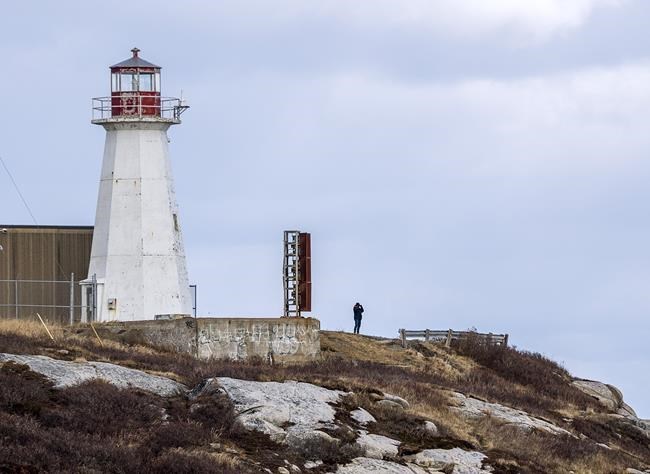
A hiker looks out from the Chebucto Head lighthouse and foghorn in Duncan's Cove, N.S. on Tuesday, Dec. 14, 2021. The foghorn went silent in February 2021 and the Canadian Coast Guard, saying the horn is one of 20 navigational aids to mariners in the area, has no plans to reactivate the fog signal. THE CANADIAN PRESS/Andrew Vaughan
December 15, 2021 - 1:00 AM
ST. JOHN'S, N.L. - The silencing this year of a familiar mournful howl at the mouth of Halifax harbour has ignited a debate about Atlantic Canada's dwindling number of foghorns.
For over 120 years, the foghorn at the Chebucto Head lighthouse has bleated a solemn warning to mariners inching through the fog. But in February, it stopped. After a coast guard technician determined it needed repairs, the agency recommended the horn be retired for good.
The decision prompted some noise of its own, says Harvey Vardy, the Canadian Coast Guard's regional director of navigational programs. A total of 42 people submitted feedback, 41 of whom opposed silencing the Chebucto Head horn.
"I can certainly recognize there is a passion for the fog signals," Vardy said in a recent interview.
The passion in the region is understandable. It was in New Brunswick that the world's first automated steam-powered foghorn was built. Civil engineer Robert Foulis came up with the idea after he heard of a tragic collision between two ships in thick fog off Newfoundland, and the first one was installed on Partridge Island in the Saint John, N.B., harbour in 1859. Today, the coast guard says, there are 91 foghorns active across Atlantic Canada, though another 46 have been decommissioned since 2013. The Partridge Island horn sounded its last blast in 1998.
Vardy said the attachment to the horns can be about nostalgia more than utility. For example, of the 41 people in favour of saving the Chebucto Head foghorn, 21 identified as pleasure craft mariners and 11 were landlubbers vouching for the horn's historical importance, he said. Nine others didn't say whether they were seafarers.
Not a single commercial mariner or marine organization — not even a fish harvester — wrote in to ask that the horn be saved, he said.
"It is internationally recognized that sound signals like foghorns are not a reliable source of navigational information," Vardy said, noting there are better navigational aids in the area, such as a light tower with a beam that can penetrate 1.8 nautical miles of dense fog. Most ships also have GPS systems that are much more reliable than a foghorn, he added.
Paul Ehler, a curator at the Out of the Fog Lighthouse Museum in Guysborough, N.S., acknowledges the decommissioning of foghorns and lighthouses saves money. "Our argument is, 'Yeah, but you're letting your history go by,'" he said in a recent interview.
He noted that each horn has its own sound pattern. The Chebucto Head horn emitted a low wail for three seconds, followed by three seconds of silence. In St. John's, N.L., the harbour foghorn sounds for two seconds and then falls quiet for 18 seconds.
But all horns have the same kind of low, resonant, almost aching sound — "a very mournful sound," said Ehler. "Lower tones, especially through dense fog, are much easier to hear than a high-pitched sound."
The horns are triggered by a fog detector, which emits a beam of light out across the harbour, he said. If the light hits a bank of fog, some particles will ping back to the detector, which then gives a read on visibility conditions depending on the time it took for the photons to return.
Foghorns are activated if visibility is reduced to two or three nautical miles, said Vardy. When visibility improves, they shut off, though the coast guard has had calls about malfunctioning horns that keep howling well after the fog lifts.
Joe Flemming, past president of the Nova Scotia Lighthouse Preservation Society, said that as a recreational boater, he's been lost in the fog and saved by a foghorn's wail. He appreciates the nostalgic argument for keeping the foghorns blowing, but he said it's the safety argument that really matters.
Sometimes, he said, the sound of the foghorn is the only thing guiding a disoriented boater to shore. "Those things exist for when equipment fails," Flemming said in a recent interview from Ketch Harbour, N.S. "It's all fine and well that some of these large commercial vessels have ... technology to get them safely in the harbour. But what about a group of sea kayakers?"
Getting lost in the fog is terrifying, like being stuck in a ferocious blizzard where there's nothing but white in all directions, he said. There's not usually much wind when the fog is thick, so it's tough to use the direction of the sea to reorient, he added.
"It's strictly a safety issue. We all love the sound of foghorns, we all love the view of lighthouses ... it's part of what our culture is here in Nova Scotia and in the Maritimes in general," Flemming said. "We can always find a reason to dismiss the nostalgia if we can't afford it. But the reality is, can we afford the lack of safety? And I would say no."
Vardy said the coast guard is still considering the feedback about the Chebucto Head foghorn before a final decision is made about its future. He's not sure when that decision will come.
This report by The Canadian Press was first published Dec. 15, 2021.
News from © The Canadian Press, 2021